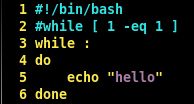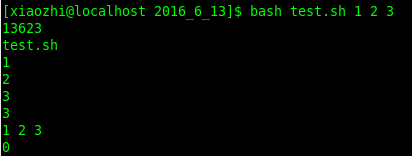转义字符:
在对文本解析时,双引号会对字符串解析,单引号保持字面含义。
echo $?本bash最近一次进程退出码
双引号用于保持引号内所有字符的字面值(回车也不例外),但以下情况除外:
条件测试:退出码0表示成功,非0表示失败
对于×××值言,
-gt表示大于即great
-ge表示大于等于great equal
-eq表示相等equal
-lt表示小于即little
-le表示小于等于
read val表示从标准输入读到val
对于字符串比较:直接使用=,==(建议使用),或!=
可选择$str1==$str2,或"X$str1"=="X$str2"(建议,防止$str1为空时直接比较,X为任意字符)
此处不可使用单引号,单引号只取字面意思
运行结果:
运行结果:
-d判断是否存在且是目录
-f判断是否存在且是普通文件
dir存在且是目录,test不存在,test.sh存在是普通文件
比较字符串最好写成如下方式:
if-elseif语句:分支
$1是一个自动变量,脚本生成时创建:第一个参数,即test.sh.
序列号容器:vector,数组下标从0开始
关联号容器:脚本容器(map:以字符串作为下标)
转载:
shell中[[]]与[]的区别?
1.概念上来说
"[[",是关键字,许多shell(如ash bsh)并不支持这种方式。ksh, bash(据说从2.02起引入对[[的支持)等支持。
"["是一条命令, 与test等价,大多数shell都支持。在现代的大多数sh实现中,"["与"test"是内部(builtin)命令。
2. 相同:二者都支持算术比较和字符串比较表达式(具体使用可能有点不同)
(1)"-gt", "-lt"是算术比较操作符,用于比较整数的大小。
(2)">", "<"是字符串比较操作符,用于比较字符串的大小,使用字典顺序,与当前的locale有关。
(3)关于字符串比较。[...]、``.``.``.``中都可以对字符串进行比较,比较的顺序是"字典顺序"。对ascii字符来讲,码表中排列在前的较小,这里只要用了"<"、">",就表示是字符串比较,那么9 > 100为真,因为这实际上等价于‘9’ > ‘100’,9在码表中排在1后面,所以字符串"9"大于字符串"100"。只要搞清楚了何时是算术比较,何时是串比较,一般就不会出错了。<><>
(4)建议在使用数值比较的时候,使用let,(())命令,否则容易出错;<>
2.1 “[“用法<>
$ [ 2 -lt 10 ]&&echo true&&echo false<>
true<>
$ [ 2 -gt 10 ]&&echo true||echo false<>
false<>
按字符串比较
$ [ 2 \< 10 ]&&echo true||echo false <>
false<>
$ [ 2 \> 10 ]&&echo true||echo false #you should use "\>"<>
true<>
2.2 “[[“用法<>
$ ` 2 -gt 10 `&&echo true||echo fa<>lse
false<>
$ ` 2 -lt 10 `&&echo true||echo false<>
true<>
仍然按字符串比较<>
$ [[ 2 < 10 ]]&&echo true||echo false<>
false<>
$ [[ 2 > 10 ]]&&echo true||echo false<>
true<>
<>
3.相同:都支持简单的模式匹配<>
这里的模式匹配要简单得多,类似文件名的统配符的扩展规则。还要注意等号右端的模式不能用引号括起,使用引用关闭了某些元字符的特殊功能<>
<>
3.1 “[“用法<>
$ [ test = test ]&&echo true||echo false <>
true<>
$ [ test = t*t ]&&echo true||echo false <>
true<>
$ [ test = t..t ]&&echo true||echo false #not match.<>
false<>
$ [ test = "t??t" ]&&echo true||echo false #alert: don't quote the pattern,使用引用关闭了?的特殊功能<>
false<>
<>
<>
3.2 “[[“用法<>
$ [[ test = test ]]&&echo true||echo false #normal compare<>
true<>
$ [[ test = t*t ]]&&echo true||echo false #pattern match.<>
true<>
$ [[ test = t..t ]]&&echo true||echo false #not match.<>
false<>
$ [[ test = t??t ]]&&echo true||echo false <>
true<>
$ [[ test = "t??t" ]]&&echo true||echo false # alert: don't quote the pattern,使用引用关闭了?的特殊功能<>
false<>
<>
4.不同点<>
4.1逻辑与和逻辑或<>
(1)"[" :逻辑与:"-a";逻辑或:"-o";<>
(2)"[[":逻辑与:"&&";逻辑或:"||"<>
$ [[ 1 < 2 && b > a ]]&&echo true||echo false<>
true<>
$ [[ 1 < 2 -a b > a ]]&&echo true||echo false<>
bash: syntax error in conditional expression<>
bash: syntax error near `-a'<>
$ [ 1 < 2 -a b > a ]&&echo true||echo false<>
true<>
$ [ 1 < 2 && b > a ]&&echo true||echo false #wrong syntax<>
bash: [: missing `]'<>
false<>
$ [ 1 < 2 \&\& b > a ]&&echo true||echo false #aslo wrong<>
bash: [: &&: binary operator expected<>
false<>
<>
<>
4.2命令行参数<>
(1)[ ... ]为shell命令,所以在其中的表达式应是它的命令行参数,所以串比较操作符">" 与"<"必须转义,否则就变成IO重定向了;<>
(2)由于"[["是关键字,不会做命令行扩展,所以在[[中"<"与">"不需转义,但是相对的语法就稍严格些。例如在[ ... ]中可以用引号括起操作符,因为在做命令行扩展时会去掉这些引号,而在` `.``.``.` `则不允许这样做;<>
$ [ "-z" "" ]&&echo true||echo false<>
true<>
$ [ -z "" ]&&echo true||echo false<>
true<>
$ [[ "-z" "" ]]&&echo true||echo false
bash: conditional binary operator expected
bash: syntax error near `""'
$ [[ -z "" ]]&&echo true||echo false
true
4.3 ` `.``.``.` `进行算术扩展,而[ ... ]不做
$ [[ 99+1 -eq 100 ]]&&echo true||echo false
true
$ [ 99+1 -eq 100 ]&&echo true||echo false
bash: [: 99+1: integer expression expected
false
$ [ $((99+1)) -eq 100 ]&&echo true||echo false
true
4.4正则表达式匹配区别
[]需加\[,\]转义。


































